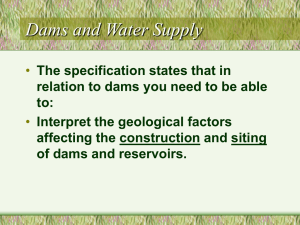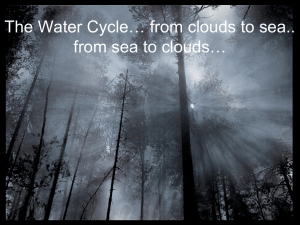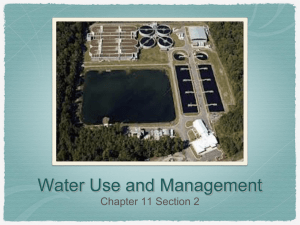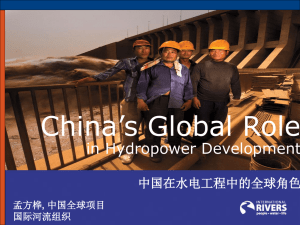Temples of Modern India? Dam Controversies Past and Present
advertisement
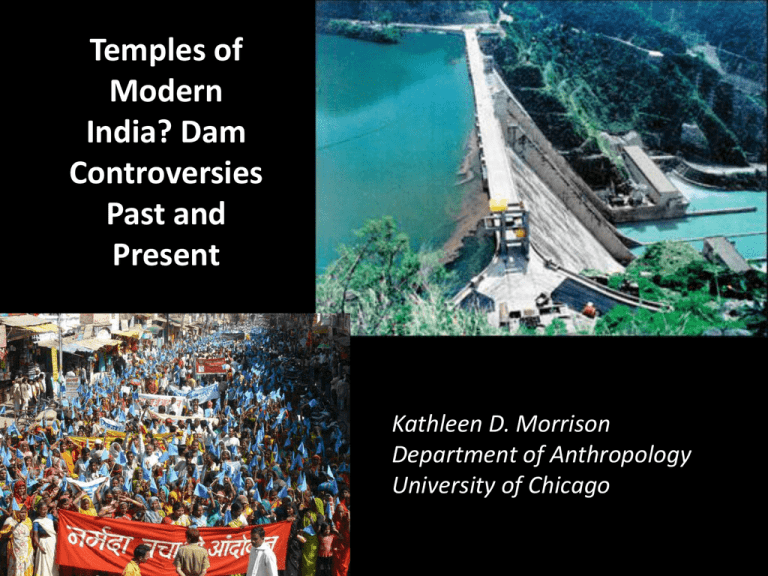
Temples of Modern India? Dam Controversies Past and Present Kathleen D. Morrison Department of Anthropology University of Chicago Dams are the temples of modern India, where I worship… --Jawaharlal Nehru, 1954. First Prime Minister of independent India Dams and the nation: independent India and the official appeal of big dams • Anti-colonial response • Modernism and science • Self-sufficiency in food production • Historical legacies • Need for food – India has a population of more than one billion and growing – rainfall is highly seasonal – Significant regional variability of rainfall – Large population living at or below poverty line • Need for power – Growing proportion living in cities – Rural electrification and agricultural uses – No oil or gas resources the present situation: polarization • Contemporary India “one of the most active dam-building countries on earth” • Multiple large projects currently underway • Significant political will shown at state & national levels • World Bank pullout • • • • Significant local protest Court challenges International pressure Academic studies The Narmada Project • • • • More than 30 major dams Power and water to primarily benefit Gujarat Displaced people and lands primarily in MP Ousteees disproportionately poor and powerless • • • • Ca. 1.5 million to be displaced No environmental studies No rehabilitation plan in place yet More than 20 years in progress thus far Protest against Narmada Project: Narmada Bachao Andolan Forms of protest developed during independence movement deployed against government-led dam projects in India In response,government points to BhakraNangal Project • Begun prior to independence, completed shortly after • Located in HP, serves Punjab , Haryana, and Rajasthan • Inundated extensive lands esp. Bilasapur state Bhakra dam • Highest concrete gravity dam in Asia • Hydroelectric • Intensive production of HYV wheat and rice • Industrialized production • Punjab “breadbasket of India” Often credited with making India self-sufficient in food Evaluating the arguments: historical perspectives on dams in India • Bhakra-Nangal and Tungabhadra Projects – 1940s-60s • Middle Period (Medieval) dams and reservoirs of south India – 10th-16th c. • Reservoirs were highly elaborated in Middle period southern India and Sri Lanka – both large and small reservoirs continue in use • The impacts of older reservoirs were comparable to those of modern ones – Ecological effects – Social effects – Cultural logics of patronage and rule The Peninsular Interior: Archaeology of an Agrarian Landscape • Contexts of patronage & construction – Elite financing – Ritual associations – Labor mobilization • Histories of reservoirs on the landscape – Patterns of construction, maintenance, and abandonment – Siltation patterns, sediment inflow • Regional Vegetation Histories – Patterns of hillside erosion and valley floor siltation – Integration of Agricultural facilities with settlements, road networks, markets, etc. Problems with large dams • Environmental problems – Submergence of forests and other ecosystems – Siltation behind the dam • Loss of fertility downstream • Loss of reservoir capacity • Exacerbation of downstream erosion • Blocked passage for migratory animals – Microenvironmental effects on climate The Mahaseer is now threatened in many Indian rivers Middle Period Reservoirs • In dry areas, could make dry crops more secure, in wetter areas allowed production of rice and other wet crops • High rate of failure – Variable rainfall, often do not fill – High evaporation rates – High siltation rates • Serious deforestation in catchments – High incidence of dam breaching • Villages washed away – Required constant maintenance Problems with large dams • Environmental Problems – Possible tectonic effects – Water pollution • Algae blooms, pesticides – Habitat for invasive plants – Waterlogging of command area – Salinization of command area • Decreases in agricultural production Tungabhadra project • Spread of invasive water hyacinth • Salinization and waterlogging are serious problems – Marginal and poor farmers most affected – Has led to loss of agricultural The Bhakra command area, too, has productivity experienced salinization and waterlogging Problems with Large Dams • Human Consequences – Inundation of land, villages, homes, sacred places • Displacement – Unequal water distribution • Exacerbates power differences • Loss of rural employment – Encouragement of commercial production • Loss of subsistence independence • Loss of local jobs Middle Period Southern India: Human Costs • Inundation caused displacement, loss of fields, grazing land • Perennially-watered areas dedicated to cash crops, commercial production • Water flow rarely equable • Construction and maintenance highly political, even for small facilities – High degree of elite investment – Changes in taxation associated with new facilities Bhakra-Nangal: human costs • 50 years later, displaced people still not fully resettled – Only landed compensated • Loss of soil fertility means crops cannot be grown without chemical fertilizers – Subsistence farming no longer possible • Rural indebtedness • Farmer suicides Problems with Large Dams • Safety and Public Health Issues – Vectors for water-borne diseases – Danger of catastrophic dam failure • Rampant corruption • Excessive siltation Area watered by both Middle period and Tungabhadra project reservoirs • Expansion of malaria into this semi-arid region by 19th century, if not before • More recently, also dengue and chikkungunya as well – Mosquito-borne Middle Period Southern India: dam failure • Daroji reservoir, built 16th c. – Still in use – In 1851, the Daroji reservoir breached, flooding and destroying Daroji village and killing several people • Virtually every one of the hundreds of dams studied has breached Breach in the Moolathara Dam near Chittur in Palakkad district of Kerala. (The Hindu, Nov. 11, 2009) Cultural Logics of Reservoirs in India: Continuity & Change • Reservoirs have special religious valence – “dams are the temples of India, where I worship” • Reservoirs have long been associated with political power and legitimate rule Alternatives? • Analysis of older dams and reservoirs shows that many problems are intrinsic to these facilities • Large dams have always been power-laden technologies, with unequal benefits and risks • Smaller-scale facilities can work, but require significant attention to watershed protection and equal access Cattle-power has been largely replaced by electric pumps 15th century canal still in use Discussion • Critiques of large dams and reservoirs – Problems of these kinds of facilities are not unique • Vision of Sustainable alternatives – Need more realistic sense of “traditional” facilities – Existing system as “facts on the ground” • Specific cultural contexts matter for both the past and present – Cultural logics of reservoir patronage in South Asia – Dams as signs of modernity and progress, “big science” Erosion near Bhadra reservoir Colonial Reservoirs • Pattern of failure and low productivity continued – Rhetoric of a previous golden age when tanks all in use and in better repair – Mosse: British saw problems as a failure of traditional village institutions, not as consequence of colonial disruptions of political relations • Parallel to “new traditionalists” • Same arguments used in Middle periods, logic of restoration – Complex variety of arrangements for control and maintenance of reservoirs What was the appeal? • Political economy of prestation – Gift-giving sign of legitimate rule – Reservoirs: smaller “package size” and resource mix than gifts of canals, temples, villages • Inscriptional analysis: Dual pattern of patronage – Pilgrimage Centers: Temples pool gifts – Urban Hinterland: Nayakas primary patrons Cultural logic of Reservoirs: the Middle Periods • Special religious merit associated with the construction of a reservoir – The “Sevenfold Progeny” • Associations with temples – Reservoirs evoke the Eternal Ocean • Snakes, makaras, elephants, lotuses • Aesthetic of greenery, water, fertility – Associated with power and order, political and gender-based British India: Emergence of the “Imperial Tank” Destructive potential of reservoirs of interest from beginning – Category of “protective” vs. “productive” works • Imperial Tanks – Breach may threaten railways – Madras Presidency • 5 in 1884-85 • 87 in 1989-99 • Reservoirs have always been power-laden technologies The “New Traditionalist” Position • Traditional irrigation was sustainable and nonexploitative – Traditional facilities are small-scale – Traditional facilities worked well and are sustainable • Represent a “lost wisdom” – Traditional facilities were community-managed • Not associated with power or exploitation • The cultural logics of traditional irrigation differ from those of contemporary projects – Latter are Western/Modern, former are Indigenous/Traditional New Traditionalism: False Dichotomies Modern • ecological transformation • failure • inequality • state power • oppression • monumental Traditional • • • • • • sustainability productivity equity local control outside of politics small Environmental and Human Costs of Reservoirs: Old & New • Modern dams and traditional tanks not different in kind – Faced many of the same problems • Transformed environments • Associated with resource inequality • High rates of failure – Scalar differences do exist but old does not mean small • Seasonality of supply probably more critical Discussion & Prospects • Romantic image of traditional irrigation detracts from legitimate critique of modern projects • Long-term historical analysis can lay foundation for realistic assessment of the possibilities of tank regeneration programs • Contemporary rhetoric on dambuilding in India takes from both western and Indian tropes

